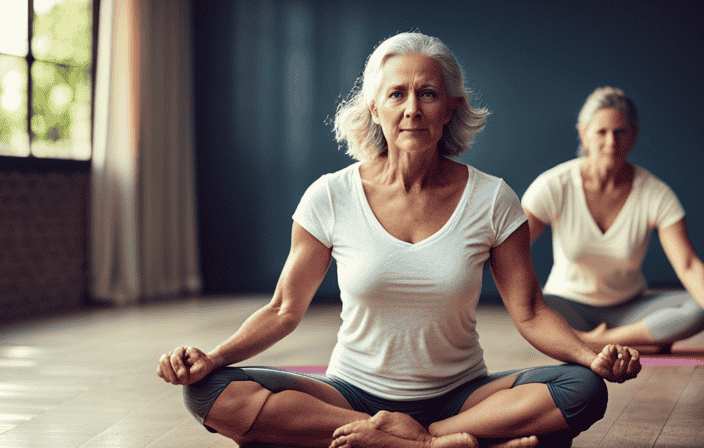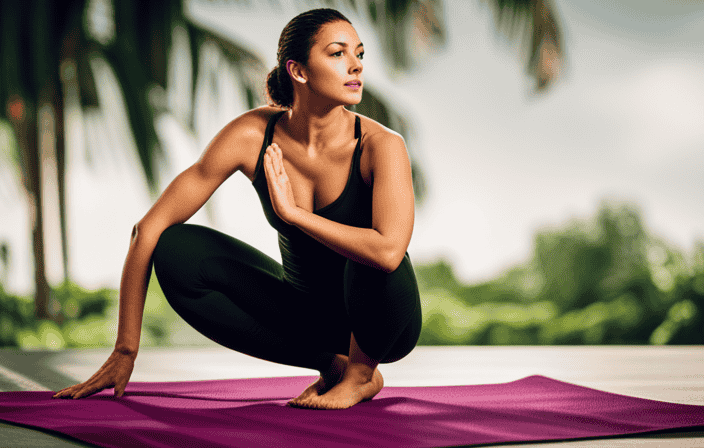Yoga
Yoga For Women: Age-Appropriate Practices For Balance And Well-Being

Ironically, in a world that continually bombards women with unrealistic beauty standards and expectations of perfection, there is a practice that embraces and supports them at all stages of life.
Yoga, a discipline that promotes balance and well-being, offers age-appropriate practices specifically tailored to the needs of women. From hormonal changes to physical flexibility, yoga provides a sanctuary where women can find inner peace, stability, and self-acceptance.
Join me on a journey through the world of yoga for women, as we explore the practices that can elevate their lives and enhance their overall well-being.
Key Takeaways
- Yoga is beneficial for women of all ages, as it adapts to their specific needs and helps maintain balance and health during hormonal changes.
- Different yoga paths and asanas are recommended for women at different life stages, with dynamic yoga suitable for young women, yin yoga recommended for middle-aged women, and breathing exercises and meditation important in old age.
- Yoga can help with unpleasant consequences of PMS, and certain yoga asanas have a beneficial effect on chemical reactions within the body, making it a natural treatment for infertility.
- Yoga helps women find inner peace and relaxation, maintain physical health and flexibility, and supports their overall well-being throughout their lives.
Age and Hormonal Balance
Yoga has been a game-changer for me in maintaining hormonal balance throughout different stages of my life.
As women, our bodies go through significant hormonal changes from puberty to menopause, and these changes can sometimes throw us off balance.
But through the practice of yoga, I have found a sense of harmony and stability. Yoga releases chemicals into the bloodstream that bring relaxation, pleasure, and balance, helping to counteract the chaos that hormonal changes can bring.
Certain yoga asanas have also been found to have a beneficial effect on chemical reactions within the body, further supporting hormonal balance.
Whether it’s dealing with PMS, menopause, or even infertility, yoga has provided me with a natural and holistic way to navigate these hormonal shifts.
Paths and Asanas
Asanas are an important component of my yoga practice, helping me strengthen my body and improve my flexibility. They are specific yoga poses that have numerous benefits for women of all ages.
For young women, dynamic styles like ashtanga and vinyasa yoga are appealing as they provide a more vigorous workout and help build strength and stamina.
As we enter middle age, calmer styles like restorative or yin yoga become more suitable, as they promote relaxation and help restore balance in the body.
During menopause, PMS, and pregnancy, certain asanas can have a beneficial effect on hormonal changes and provide relief from discomfort.
In old age, asanas, breathing exercises, and meditation are crucial for maintaining physical health, flexibility, and mental well-being.
By incorporating asanas into my yoga practice, I am able to address the specific needs of my body at each stage of life, promoting balance and overall well-being.
Hormonal Changes and Yoga
During hormonal changes, I have found that incorporating specific poses into my practice helps maintain my body’s balance and promotes overall well-being. Yoga has been a great tool for me to navigate through these changes and alleviate any discomfort. Certain yoga asanas have a beneficial effect on the chemical reactions within the body, helping to restore hormonal balance. To provide a visual representation of these poses, here is a table showcasing some asanas that can be helpful during hormonal changes:
| Asana | Benefits |
|---|---|
| Child’s Pose | Relieves menstrual cramps |
| Bridge Pose | Stimulates the ovaries |
| Cat/Cow Pose | Regulates hormone production |
| Legs-Up-The-Wall | Calms the nervous system and reduces stress |
Incorporating these poses into my yoga practice has made a significant difference in managing hormonal changes. They provide relief, balance, and promote overall well-being. Yoga truly is a powerful tool for women during all stages of life.
Yoga for Different Life Stages
Throughout different stages of my life, I have discovered that incorporating various styles of yoga has been beneficial for my overall physical and mental health.
In my younger years, dynamic styles like ashtanga and vinyasa yoga were appealing to me. They helped me build strength, flexibility, and improved my cardiovascular health.
As I entered middle age, I found that calmer styles like restorative or yin yoga were more suitable. They allowed me to slow down, find inner peace, and relieve stress.
Now, in old age, I focus on breathing exercises and meditation. These practices help me maintain a sense of calm and clarity, and they are essential for my overall well-being.
Regardless of the stage of life, yoga has adapted to my changing needs and continues to support my balance and well-being.
Inner Peace and Flexibility
Incorporating calming styles of yoga, like restorative or yin, has helped me find inner peace and maintain flexibility throughout my journey. These styles of yoga have played a crucial role in my overall well-being. Here are three ways in which they have benefited me:
-
Reduced stress: Restorative and yin yoga focus on deep relaxation and gentle stretching. By practicing these styles, I have been able to release tension and calm my mind, leading to a significant reduction in stress levels.
-
Increased energy: These styles of yoga require less physical effort compared to dynamic styles. They have helped me recharge and restore my energy levels, leaving me feeling revitalized and rejuvenated.
-
Improved flexibility: Regular practice of restorative and yin yoga has helped me maintain the elasticity and flexibility of my body. Through gentle, prolonged stretches, I have noticed an increase in my range of motion and improved muscle flexibility.
Incorporating these calming styles of yoga into my routine has not only brought me inner peace but also enhanced my physical well-being.
Yoga for All Ages
I have found that practicing yoga at different stages of my life has been incredibly beneficial for my overall health and happiness.
Yoga is a practice that can be adapted to suit the needs of women at any age. Whether you are a young woman looking to build strength and flexibility, a middle-aged woman seeking calm and balance, or an older woman wanting to maintain physical health and independence, yoga has something to offer.
For young women, dynamic styles like ashtanga and vinyasa yoga can be appealing, while calmer styles like restorative or yin yoga are more suitable for middle-aged women.
As we age, asanas, breathing exercises, and meditation become increasingly important, helping us find inner peace and maintain flexibility.
No matter what stage of life you are in, it is never too early or too late to start practicing yoga and elevate the quality of your life.
Connection with Nature
Now that we have explored the importance of yoga for women of all ages, let’s delve into another fascinating aspect of this practice: its connection with nature.
As a woman who has personally experienced the transformative power of yoga, I can attest to the profound connection it fosters with the natural world around us. Through various asanas, breathing exercises, and meditation, yoga allows us to tune in to the rhythms of nature and tap into its innate wisdom. It reminds us that we are intricately linked to the cycles of the day, month, and year.
Incorporating this connection into our practice not only brings a sense of grounding and stability, but also enhances our overall well-being. It allows us to align with the ebb and flow of life, finding balance and harmony within ourselves and with the world around us.
Let’s explore three ways in which yoga connects us with nature:
- Through mindful movement, yoga invites us to embody the grace and fluidity of natural elements like water, air, and earth.
- Breathing exercises in yoga help us synchronize our breath with the rhythms of nature, fostering a deep sense of calm and inner peace.
- Meditation in nature, whether it’s practicing under a tree or by a serene body of water, allows us to connect with the beauty and stillness of the natural world, grounding us in the present moment.
By cultivating this connection with nature, we not only enhance our yoga practice but also deepen our connection with ourselves and the world around us. So, let’s step onto our mats and embark on a journey of self-discovery, guided by the wisdom and beauty of nature.
Stability and Availability
Fostering stability and availability, yoga connects us with the natural world and allows us to align with its rhythms and wisdom.
As women, we are innately connected to nature and its changes. Yoga helps us maintain stability, reasonableness, and availability, enabling us to navigate through life’s challenges with grace and resilience.
Through yoga, we learn to listen to our bodies and honor their needs, fostering a sense of inner stability. By being present in the moment, we cultivate availability, allowing ourselves to fully engage with the world around us.
This connection with nature and our own being brings a profound sense of grounding and balance. Yoga empowers us to find stability amidst life’s uncertainties and to be available to ourselves and others, nurturing our overall well-being.
Self-Acceptance and Understanding
Self-acceptance and understanding are fostered through the practice of yoga, allowing me to embrace and appreciate myself fully. Yoga has taught me to listen to my body, honor its needs, and accept it as it is in each moment. It has helped me understand that I am unique, with my own strengths and limitations, and that’s okay. Through yoga, I have learned to let go of self-judgment and comparison, and instead focus on self-compassion and growth.
Yoga teaches me to be present: Each time I step onto my mat, I am encouraged to be fully present in the moment, to observe my thoughts and emotions without judgment. This practice of mindfulness helps me cultivate self-awareness and acceptance.
Yoga encourages self-compassion: Yoga reminds me to be kind and gentle with myself, both on and off the mat. It teaches me to treat myself with love and respect, knowing that I am deserving of kindness and understanding.
Yoga promotes self-discovery: Through the practice of yoga, I am able to explore my body, mind, and spirit in a safe and nurturing environment. It allows me to uncover new layers of myself, to discover my true potential, and to embrace all aspects of who I am.
In conclusion, yoga has been a powerful tool in fostering self-acceptance and understanding. It has taught me to appreciate myself as a whole, with all my imperfections and strengths. Through the practice of yoga, I have gained a deeper understanding of myself and have learned to embrace and love the person I am.
Yoga Industry and Women
In the yoga industry, there is a wide range of products and services available specifically tailored to meet the needs and preferences of female practitioners. More than 80 percent of yoga students are female, and the industry recognizes the importance of catering to their unique requirements. From specialized yoga clothing designed for comfort and style, to footwear that provides support and stability, the market offers a variety of options. Additionally, yoga gadgets such as mats, blocks, and straps are designed to enhance and deepen the practice for women. Many women even enjoy practicing yoga on paddle boards, combining the benefits of water and yoga. The yoga industry understands the popularity of yoga among women and strives to provide products and services that support their journey towards balance and well-being.
| Yoga Products for Women | Benefits |
|---|---|
| Specialized Clothing | Comfort and style |
| Supportive Footwear | Stability and support |
| Yoga Gadgets | Enhanced practice |
| Paddle Boards | Combines yoga and water benefits |
This commitment to women’s needs reflects the understanding that yoga is not only a physical practice but also an emotional and spiritual journey. By providing the right tools and resources, the industry empowers women to fully embrace and enjoy their yoga practice, ultimately enhancing their overall well-being.
Importance of Yoga for Women
Maintaining a regular yoga practice can greatly enhance my overall physical, mental, and emotional health as a woman. Yoga offers numerous benefits that support my well-being and help me find balance in all aspects of my life.
Yoga improves flexibility and strength, keeping my body in good shape. It helps me manage stress and find inner peace, allowing me to navigate life’s challenges with ease. Yoga promotes mindfulness and self-awareness, helping me connect with my body and emotions on a deeper level.
By incorporating yoga into my daily routine, I can experience the transformative power it has on my physical and mental state. It is a healthy habit that uplifts the quality of my life, ensuring that I can lead a balanced and fulfilled existence as a woman.
Frequently Asked Questions
How can yoga help women with infertility?
Yoga can be a natural treatment for infertility in women. Certain yoga asanas have a beneficial effect on chemical reactions in the body, helping to maintain hormonal balance and overall health, which can increase fertility.
What are the best yoga styles for women experiencing PMS?
When experiencing PMS, I find that practicing calming yoga styles like restorative or yin yoga helps alleviate symptoms. These gentle practices promote relaxation and balance, providing relief during this time of hormonal changes.
Can yoga help with the symptoms of menopause?
Yes, yoga can help with the symptoms of menopause. It can assist in maintaining hormonal balance, reducing hot flashes and mood swings, improving sleep quality, and promoting overall well-being during this transitional phase of a woman’s life.
Are there specific yoga asanas that are beneficial during pregnancy?
Yes, there are specific yoga asanas that are beneficial during pregnancy. Prenatal yoga focuses on gentle stretches, strengthening exercises, and breathing techniques to help support the changing body and promote relaxation.
What are the benefits of yoga for older women in terms of maintaining independence and control?
As an older woman, yoga has been instrumental in maintaining my independence and control. Through regular practice, I have improved my physical health, found inner peace, and gained a greater sense of self-awareness and acceptance.
Conclusion
In conclusion, yoga is a powerful practice that offers women of all ages the opportunity to find balance and well-being in their lives. It symbolizes the journey of self-discovery and inner peace, allowing women to connect with their bodies and embrace their unique needs.
By incorporating age-appropriate practices and asanas, yoga supports hormonal balance and helps navigate the challenges of different life stages. It is a tool for maintaining physical health, flexibility, and independence, while also providing a sense of stability and self-acceptance.
The yoga industry recognizes the importance of catering to women’s needs, offering specialized products to enhance their yoga experience. Embrace the power of yoga and elevate the quality of your life.
Meet Nadi, the soulful writer and explorer of inner realms who graces OurMindAndBody.com with her profound insights and heartfelt wisdom. With a profound passion for mindfulness, meditation, and spiritual growth, Nadi weaves words that touch the hearts and minds of readers, leaving a lasting impact on their well-being journey.
Rooted in a background of philosophy and psychology, Nadi’s curiosity about the human mind and the mysteries of the soul led her on a transformative path of self-discovery. Drawn to the transformative power of mindfulness and meditation, she embarked on a quest to understand the intricacies of these practices, not only for her own growth but also to inspire others to embark on their own inner journeys.
Yoga
Sustainable Yoga Mat Towels For A Slip-Free Practice

According to a recent survey, there is a growing preference for eco-friendly yoga mat towels among practitioners, who are opting for sustainable options to enhance their yoga practices.
In response to this growing trend, several brands have emerged as leaders in the field of sustainable yoga accessories. Yogitoes Yoga Mat Towel and Ekaminhale Organic Yoga Rug are two such options that offer excellent grip and moisture absorption while prioritizing environmental responsibility.
In this article, we will explore the top sustainable yoga mat towels of 2022 and delve into the eco-friendly practices of these brands, enabling yogis to make informed choices for a slip-free and environmentally conscious practice.
Key Takeaways
- Sustainable yoga mat towels are made from eco-friendly materials and help reduce reliance on non-renewable resources.
- These towels are durable and long-lasting, minimizing the need for frequent replacements and saving money in the long run.
- They provide a non-slip surface for a secure yoga practice, helping prevent injuries and enhancing the overall yoga experience.
- Choosing sustainable yoga mat towels contributes to a more sustainable practice and a greener future, while also supporting eco-friendly manufacturing practices.
Top Yoga Mat Towels 2022
The selection of top yoga mat towels in 2022 includes options such as the Yoga Mate Soft Non-Slip Bikram Yoga Mat, REEHUT Hot Yoga Towel, IUGA Non Slip Yoga Towel, Ekaminhale Organic Yoga Rug, and Yogitoes Yoga Mat Towel, each offering unique features and benefits for a slip-free and sustainable yoga practice.
When it comes to finding the best non-slip towel, the Yoga Mate Soft Non-Slip Bikram Yoga Mat and REEHUT Hot Yoga Towel are popular choices. These towels are designed to absorb sweat and maintain balance, providing a slip-free surface for your practice.
On the other hand, the IUGA Non Slip Yoga Towel is known for its excellent sweat-absorbing properties and corner pockets for stability.
For those looking for an eco-friendly option, the Yogitoes Yoga Mat Towel stands out, as it is made from recycled materials and requires less energy to produce.
These top sweat-absorbing towels ensure a slip-free practice while also promoting sustainability.
Best Absorbent Towel
Featuring exceptional absorbency, the top-rated yoga towel in terms of moisture absorption is the Yoga Mate Soft Non-Slip Bikram Yoga Mat.
This towel is made from high-quality and durable microfibers, which are known for their ability to quickly absorb sweat and maintain balance during yoga practice. Compared to cotton towels, microfiber towels have a more dense and soft texture, allowing for better moisture absorption and preventing slips on the mat.
Using a non-slip yoga towel provides numerous benefits, including enhanced grip and stability, which can help prevent injuries and improve overall performance. Additionally, non-slip towels are more hygienic, as they prevent the accumulation of sweat and bacteria on the mat’s surface.
Incorporating a high-quality, absorbent towel like the Yoga Mate Soft Non-Slip Bikram Yoga Mat can greatly enhance your yoga practice, providing a slip-free and comfortable experience.
Premium Microfiber Towel
Composed of high-quality microfiber, the premium towel offers exceptional moisture absorption and a slip-resistant surface. With its sustainable manufacturing methods and eco-conscious approach, this towel is not only beneficial for your yoga practice but also for the environment. The use of recycled materials and reduced energy consumption during production aligns with the company’s commitment to sustainability. The slip-resistant technology ensures that you maintain stability and balance during your practice, enhancing your overall experience. To provide a visual representation of its features, the table below highlights the key attributes of the premium microfiber towel:
| Key Features | |
|---|---|
| Material | High-quality microfiber |
| Moisture Absorption | Exceptional |
| Slip Resistance | Yes |
| Sustainable | Yes |
| Eco-friendly | Yes |
In summary, the premium microfiber towel not only offers excellent moisture absorption and slip resistance but also demonstrates a dedication to sustainable manufacturing practices.
Organic Cotton Rug
Handcrafted with GOTS certified organic cotton, the organic cotton rug provides a natural and environmentally friendly option for practitioners. This handcrafted cotton rug is not only sustainable but also biodegradable, making it an ideal choice for eco-conscious yogis.
Here are some key features of the organic cotton rug:
-
GOTS certified: The rug is made from organic cotton that meets the Global Organic Textile Standard (GOTS), ensuring its authenticity and sustainability.
-
Biodegradable: Unlike synthetic materials, the organic cotton rug is biodegradable, reducing its impact on the environment.
-
Eco-friendly: By using an organic cotton rug, practitioners can support sustainable farming practices and reduce their carbon footprint.
-
Soft and comfortable: The rug’s natural fibers provide a soft and comfortable surface for yoga practice.
-
Versatile: Suitable for various yoga styles, the organic cotton rug can be used as a mat or placed on top of a yoga mat for added grip and cushioning.
With its handcrafted nature and sustainable properties, the organic cotton rug offers a conscious and eco-friendly choice for yogis seeking a slip-free practice.
Eco-Friendly Yogitoes Towel
Manufactured with a strong emphasis on environmental consciousness, the Yogitoes towel stands out as an eco-friendly option for practitioners seeking a sustainable and responsible choice for their yoga practice. The company’s commitment to eco-friendly manufacturing and sustainability is admirable. Yogitoes utilizes recycled materials in their production process, reducing energy consumption and supporting a greener future. By requiring 66% less energy to produce, this towel significantly minimizes its environmental impact. Not only does it prioritize sustainability, but it also offers exceptional functionality. The Yogitoes towel features non-slip, sweat-wicking, and skid-less technology, making it suitable for any type of yoga practice. By choosing the eco-friendly Yogitoes towel, practitioners can not only enhance their own practice but also contribute to the preservation of the planet.
| Pros | Cons |
|---|---|
| Eco-friendly manufacturing | None |
| Sustainability commitment | None |
| Made from recycled materials | None |
| Reduces energy consumption | None |
Yogitoes’ Environmental Commitment
Admirably, Yogitoes demonstrates a strong commitment to the environment through their eco-friendly practices and the use of recycled materials in their production process. This commitment to sustainability is evident in the following ways:
-
Environmentally Conscious Manufacturing: Yogitoes focuses on reducing energy consumption during the production of their yoga mat towels. By utilizing recycled materials, they significantly decrease the amount of energy required to produce each towel, making them more environmentally friendly.
-
Recycled Materials: Yogitoes incorporates recycled materials into their yoga mat towels, further reducing their environmental impact. This not only helps to minimize waste but also gives the towels a unique texture and feel.
-
Supporting a Greener Future: By prioritizing sustainability in their manufacturing processes, Yogitoes actively supports a greener future. Their use of recycled materials and reduced energy consumption contributes to the preservation of natural resources and the overall well-being of the planet.
Through their sustainability initiatives and the incorporation of recycled materials, Yogitoes exemplifies how eco-friendly practices can be seamlessly integrated into the production of slip-free yoga mat towels.
Yogitoes’ commitment to reducing energy consumption and utilizing recycled materials in their production process exemplifies their dedication to environmental sustainability. By focusing on eco-friendly manufacturing, Yogitoes not only reduces their carbon footprint but also supports a greener future.
The use of recycled materials in their yoga mat towels significantly reduces waste and the need for new resources. Choosing a sustainable yoga mat towel has several benefits. Firstly, it helps to minimize environmental impact by reducing the consumption of non-renewable resources. Secondly, eco-friendly towels often possess non-slip and sweat-wicking properties, making them ideal for a slip-free practice.
When selecting a sustainable yoga mat towel, it is important to look for materials such as organic cotton or recycled microfiber. Additionally, considering the durability and longevity of the towel can contribute to reducing waste in the long run.
By making conscious choices, practitioners can contribute to a more sustainable and eco-conscious yoga practice.
By choosing environmentally conscious alternatives, practitioners can embrace a more harmonious and earth-minded approach to their yoga journey, fostering a deeper connection to the natural world.
Sustainable yoga mat towels offer numerous benefits, both for the individual and the planet. Firstly, they are made from eco-friendly materials such as recycled fibers or organic cotton, reducing the reliance on non-renewable resources.
Secondly, these towels are designed to be durable and long-lasting, minimizing the need for frequent replacements.
Lastly, sustainable yoga mat towels often have non-slip features, providing a secure and slip-free practice while reducing the risk of injuries.
When choosing an eco-friendly yoga mat towel, consider the following tips: opt for towels made from recycled materials, look for certifications such as GOTS (Global Organic Textile Standard), and choose towels that are free from harmful chemicals and toxins.
By making conscious choices, practitioners can contribute to a greener and more sustainable future.
Frequently Asked Questions
What is the best way to care for and clean a sustainable yoga mat towel?
To care for and clean eco-friendly yoga mat towels, follow these tips: 1) Machine wash with cold water and mild detergent. 2) Air dry or tumble dry on low heat. 3) Avoid using fabric softeners or bleach. 4) Regularly inspect for wear and tear.
Are there any specific yoga poses or practices that the eco-friendly Yogitoes towel is particularly well-suited for?
The Yogitoes Yoga Mat Towel is well-suited for specific yoga poses and practices due to its non-slip, sweat-wicking, and skid-less technology. It provides stability and grip, enhancing the practitioner’s balance and alignment during various yoga poses.
How does the Yogitoes towel’s non-slip and skid-less technology work?
The Yogitoes towel’s non-slip and skid-less technology is achieved through its unique design and materials. The towel is made from recycled materials and features a specialized grip pattern that enhances traction and prevents slipping during yoga practice. To maintain a sustainable yoga mat towel, it is important to follow the manufacturer’s care instructions, which may include washing with eco-friendly detergents and air-drying whenever possible.
Can the organic cotton rug be used as a standalone yoga mat, or is it necessary to use it in conjunction with another mat?
The organic cotton rug can be used as a standalone yoga mat, but it is recommended to use it with another mat for added support. Using it alone provides a more natural and eco-friendly option, while using it with another mat offers enhanced stability and cushioning.
Does the IUGA non-slip yoga towel come in different sizes or is it one-size-fits-all?
The IUGA non-slip yoga towel is available in different sizes to accommodate various yoga mat dimensions. Using a non-slip yoga towel provides advantages such as enhanced stability, moisture absorption, and a slip-free surface for a safer and more effective practice.
Meet Nadi, the soulful writer and explorer of inner realms who graces OurMindAndBody.com with her profound insights and heartfelt wisdom. With a profound passion for mindfulness, meditation, and spiritual growth, Nadi weaves words that touch the hearts and minds of readers, leaving a lasting impact on their well-being journey.
Rooted in a background of philosophy and psychology, Nadi’s curiosity about the human mind and the mysteries of the soul led her on a transformative path of self-discovery. Drawn to the transformative power of mindfulness and meditation, she embarked on a quest to understand the intricacies of these practices, not only for her own growth but also to inspire others to embark on their own inner journeys.
Yoga
Sleep Better: Alleviate Back Pain With Simple Tips

Tired of tossing and turning all night due to back pain? Look no further! This article will explore simple tips to improve your sleep and alleviate back pain.
From choosing the right mattress to incorporating stretching routines, we will provide you with effective strategies to improve your sleep quality and overall health.
Discover the benefits of memory foam mattresses and learn when to seek medical aid for severe pain.
Say goodbye to sleepless nights and hello to a pain-free slumber!
Key Takeaways
- Choosing the right mattress, such as a memory foam mattress, can provide proper support for your back and improve sleep quality.
- Using heating and cooling packs can help relieve back pain by reducing inflammation and providing pain relief.
- Incorporating a stretching routine, especially focusing on lower back stretches and core strengthening exercises, can help alleviate tension and back pain.
- Seeking medical aid, such as physical or massage therapy, and consulting a doctor for severe pain and injuries is important for proper treatment and to prevent further complications.
What Causes Back Pain?
Back pain can be attributed to a variety of factors, including past injuries and the natural process of aging, which can significantly impact daily activities and disrupt sleep.
Common causes of back pain include muscle strains, ligament sprains, herniated discs, and spinal stenosis. Additionally, poor posture, obesity, and lack of exercise can also contribute to the development of back pain.
Natural remedies for back pain include maintaining a healthy weight, engaging in regular exercise, practicing good posture, and using proper body mechanics when lifting heavy objects. Other remedies such as heat therapy, cold therapy, and over-the-counter pain medications can also provide temporary relief.
It is important to address back pain promptly to prevent further complications and to seek medical advice if the pain persists or worsens.
Importance of Sleep
Quality rest is crucial for both mental and physical well-being, and insufficient sleep can have a detrimental impact on overall health. Sleep deprivation and sleep disorders can disrupt the body’s natural healing process and exacerbate back pain.
To address these issues and improve sleep quality, consider the following:
-
Establish a consistent sleep schedule: Going to bed and waking up at the same time every day helps regulate the body’s internal clock and promotes better sleep.
-
Create a sleep-conducive environment: Make sure your bedroom is quiet, dark, and at a comfortable temperature to promote relaxation and minimize disturbances during sleep.
-
Practice good sleep hygiene: Avoid stimulating activities before bedtime, limit caffeine intake, and create a relaxing bedtime routine to signal your body that it’s time to sleep.
-
Seek medical help for sleep disorders: If you suspect you have a sleep disorder, such as sleep apnea or insomnia, consult a healthcare professional for an accurate diagnosis and appropriate treatment.
By prioritizing sleep and implementing these strategies, you can alleviate back pain and improve overall sleep quality.
Effects of Back Pain
The impact of back pain on daily functioning and sleep can be likened to a dark cloud that hinders productivity and restfulness.
Back pain, which can be caused by various factors such as past injuries and aging, significantly affects daily activities and sleep quality.
It is crucial to address back pain promptly to prevent further complications. Preventing back pain through proper posture, regular exercise, and maintaining a healthy weight is essential.
For those suffering from chronic back pain, managing it effectively is crucial. This can include seeking medical aid, such as physical and massage therapy, and consulting a doctor for severe pain and injuries. Additional treatments may be necessary to alleviate chronic pain and improve overall well-being.
By taking proactive steps to prevent and manage back pain, individuals can experience improved daily functioning and sleep quality.
Benefits of Memory Foam
Memory foam mattresses offer optimal support and weight distribution, conforming to the body’s natural curves and promoting improved sleep posture. Unlike traditional mattresses, memory foam mattresses are designed to provide individualized comfort by contouring to the body’s shape. This helps to alleviate pressure points, reduce tossing and turning, and minimize back pain. When choosing a memory foam mattress, it is important to consider factors such as density, thickness, and firmness level. Higher density mattresses offer better support and durability, while thicker mattresses provide deeper cushioning. Additionally, selecting a firmness level that suits your personal preference and sleeping style can further enhance your sleep experience. By investing in a high-quality memory foam mattress that suits your needs, you can enjoy a more comfortable and pain-free night’s sleep.
| Memory Foam Mattresses | Traditional Mattresses |
|---|---|
| Optimal Support | Limited Support |
| Conforms to Curves | Less Conforming |
| Reduces Pressure Points | May Cause Pressure Points |
| Minimizes Back Pain | May Aggravate Back Pain |
| Individualized Comfort | Generic Comfort |
| Better Sleep Posture | Less Supportive Sleep Posture |
When to Seek Medical Aid
If experiencing persistent or severe discomfort in the back, seeking medical attention is advisable. While there are various self-help measures for alleviating back pain, certain cases may require professional intervention. Physical therapy is a commonly recommended approach for back pain management. It involves exercises and techniques aimed at strengthening the muscles, improving flexibility, and enhancing overall posture. On the other hand, massage therapy focuses on manipulating the soft tissues of the body to relieve tension and reduce pain. Both physical and massage therapy can be effective in treating back pain, but the choice depends on the individual’s specific condition and preferences.
When discussing sleeping issues with a physician, it is important to provide detailed information about the nature and intensity of the pain experienced during sleep. Mentioning the frequency and duration of the discomfort, as well as any aggravating or relieving factors, can also assist the physician in making an accurate diagnosis. Furthermore, it is essential to communicate any previous attempts to alleviate the pain, such as changes in sleeping positions or the use of different mattresses. By providing this information, the physician can better understand the underlying causes of the sleep disturbances and recommend appropriate treatments or interventions.
Seeking medical attention for persistent or severe discomfort in the back is advisable, as professional intervention may be necessary. Back pain can significantly impact daily activities and sleep quality, making it crucial to address the issue promptly. While lifestyle changes, such as choosing the right mattress and improving sleep habits, can alleviate back pain, some cases require additional medical treatments. Consulting a doctor is essential for individuals experiencing severe pain or injuries, as they can provide guidance on appropriate therapies like physical or massage therapy. It is also important to discuss any sleeping issues with a physician, as they can offer further insight and recommend suitable interventions. By seeking medical aid, individuals can receive proper treatment to reduce or eliminate back pain and prevent potential complications.
| Choosing the right mattress | Importance of sleep |
|---|---|
| Soft mattresses lack support and can exacerbate back pain. | Sleep is vital for mental and physical wellness, and lack of sleep can worsen back pain. |
| Hard mattresses can be uncomfortable and cause discomfort. | Good sleep improves overall health and can alleviate back pain. |
| Memory foam mattresses follow the body’s natural curve, providing proper support and weight distribution. | Proper weight distribution and cradling of the body’s curves by memory foam mattresses can improve sleep quality and reduce back pain. |
Consulting a healthcare professional can provide valuable guidance and assistance in managing persistent discomfort and promoting overall well-being. When it comes to preventing back pain and achieving a better night’s sleep, the choice of sleeping positions plays a crucial role.
Here are three best sleeping positions for back pain relief:
-
Sleeping on your side with a pillow between your knees: This position helps align the spine and reduces pressure on the lower back.
-
Sleeping on your back with a pillow under your knees: This position maintains the natural curve of the spine and provides support to the back.
-
Sleeping in a fetal position: This position with the knees drawn towards the chest can relieve pressure on the discs in the spine and promote better sleep.
By adopting these sleeping positions, individuals can alleviate back pain and improve their sleep quality, leading to better overall health and well-being.
When it comes to alleviating back pain, effective stretching routines and proper mattress selection play crucial roles.
Stretching routines are known to provide relief by relieving tension and improving flexibility. Incorporating lower back stretches and core strengthening exercises into a daily routine can help reduce discomfort.
Additionally, selecting the right mattress is essential for back pain management. Soft mattresses may lack support, while hard ones can be uncomfortable. Memory foam mattresses, on the other hand, are designed to follow the body’s natural curve, providing proper weight distribution and comfort.
By cradling the body’s curves, memory foam mattresses not only improve sleep quality but also reduce back pain. Therefore, individuals experiencing back pain should consider incorporating effective stretching routines and investing in a suitable mattress to alleviate their discomfort and promote better sleep.
Frequently Asked Questions
How does stress contribute to back pain?
Stress can contribute to back pain by increasing muscle tension and reducing blood flow to the back. Stress management techniques, such as relaxation exercises and mindfulness, can help alleviate emotional strain and potentially reduce the impact of stress on back pain.
Can poor posture during the day affect back pain at night?
Poor posture during the day can contribute to nighttime discomfort and back pain. Maintaining good posture throughout the day helps alleviate strain on the back and promotes proper spinal alignment, leading to a more comfortable sleep.
Are there any specific exercises or stretches that can alleviate back pain?
Exercises and stretches, such as the cat-camel stretch and the child’s pose in yoga, can alleviate back pain. Lifestyle changes, such as maintaining good posture and regular physical activity, can also help prevent back pain.
Can a lack of sleep worsen back pain?
A lack of sleep can worsen back pain and impact the recovery process. Sleep deprivation can increase inflammation and sensitivity to pain, making it more difficult for the body to heal and recover from back pain.
Are there any lifestyle changes that can help prevent back pain?
Ergonomic workstations and regular exercise are effective lifestyle changes for preventing back pain. Ergonomic workstations promote proper posture and reduce strain on the back, while regular exercise strengthens the muscles and improves flexibility to support the spine.
Meet Nadi, the soulful writer and explorer of inner realms who graces OurMindAndBody.com with her profound insights and heartfelt wisdom. With a profound passion for mindfulness, meditation, and spiritual growth, Nadi weaves words that touch the hearts and minds of readers, leaving a lasting impact on their well-being journey.
Rooted in a background of philosophy and psychology, Nadi’s curiosity about the human mind and the mysteries of the soul led her on a transformative path of self-discovery. Drawn to the transformative power of mindfulness and meditation, she embarked on a quest to understand the intricacies of these practices, not only for her own growth but also to inspire others to embark on their own inner journeys.
Yoga
Ultimate Guide To Choosing The Perfect Yoga Headband

In the world of yoga, finding the perfect headband is like searching for inner peace – it requires patience, insight, and a thorough understanding of your own needs. With so many options available, it can be overwhelming to choose the right one. But fear not, this comprehensive guide is here to provide you with the knowledge and details you need to make a well-informed decision.
From the features and benefits to the top brands and materials, we will explore every aspect of selecting the perfect yoga headband.
So, let us embark on this journey together and uncover the secrets to finding the ideal companion for your yoga practice.
Key Takeaways
- Temple Tape Headbands are a popular choice due to their ability to absorb and evaporate sweat quickly, their slim and lightweight design, and their grip and non-slip technology.
- Maven Thread Womens Headbands are known for their stretchy fabric design, their ability to quickly wick away sweat, and their versatility as both a yoga accessory and a fashion accessory.
- Calbeing Headbands are praised for their soft and stretchy material, their ability to wick moisture away, and their stylish and easy-to-use design.
- GAIAM Banyan and Bo Hot Yoga Headbands stand out for their extra wide design, their ability to absorb sweat, and their use of silicone strips to keep them secure.
Features and Benefits
The features and benefits of various yoga headbands have been discussed, including their ability to absorb and evaporate sweat, their lightweight and breathable designs, their non-slip technology, and their versatility as both a functional and fashionable accessory.
These headbands offer fashionable options for individuals with different hair types. The Temple Tape Headbands, for example, are unisex and fit all sizes, making them suitable for everyone.
The Maven Thread Womens Headband is stretchy and can be used as a fashion accessory. The Calbeing Headband is soft and stretchy, ensuring a comfortable fit for all.
Lastly, the GAIAM Banyan and Bo Hot Yoga Headband has an extra wide design and is made of polyester, nylon, and spandex, making it suitable for individuals with different hair types.
Top Brands
GAIAM Banyan and Bo Hot Yoga Headband, with its extra wide design and silicone strip technology, stands out among the top brands in providing a secure and sweat-absorbing headband option for yoga enthusiasts. The extra width of the headband ensures better coverage and prevents hair from falling into the face during intense yoga sessions. The silicone strip technology helps to keep the headband in place, even during vigorous movements.
According to customer reviews, GAIAM Banyan and Bo Hot Yoga Headband is highly praised for its sweat-absorbing capabilities and durability. The headband is made of a blend of polyester, nylon, and spandex, which allows it to wick away moisture effectively. Customers also appreciate the stylish design and comfortable fit of the headband. However, it is important to note that this headband does not have a non-slip feature, which may be a drawback for some users.
Overall, GAIAM Banyan and Bo Hot Yoga Headband is a top brand choice for those looking for a reliable and functional yoga headband.
Material and Design
Polyester, nylon, and spandex are commonly used materials in the construction of yoga headbands, ensuring effective moisture-wicking and durability. These materials offer a comfortable and breathable experience during yoga sessions, as they are designed to absorb and evaporate sweat quickly.
The stretchy nature of the fabric ensures a snug fit that stays in place, providing comfort and stability throughout the practice. Additionally, the use of these materials allows for a wide range of stylish designs and fashion trends, making yoga headbands not only functional but also a fashion accessory.
Whether it’s a vibrant pattern or a sleek solid color, yoga headbands made from polyester, nylon, and spandex offer both comfort and style, catering to the needs and preferences of yoga enthusiasts.
Sweat Absorption
Sweat absorption is a significant factor to consider when selecting a suitable yoga headband for optimal comfort and performance. To ensure sweat is effectively managed during intense yoga sessions, it is essential to choose a headband that incorporates moisture-wicking technology.
This technology allows the fabric to pull moisture away from the skin and quickly evaporate it, keeping the head dry and comfortable.
Additionally, sweat absorption can be enhanced by headbands that utilize sweat management techniques such as absorbent materials or silicone strips. These features not only prevent sweat from dripping into the eyes but also help to keep the headband securely in place during vigorous movements.
By prioritizing sweat absorption in a yoga headband, practitioners can maintain focus and enjoy a sweat-free and comfortable workout experience.
Price and Value
When considering yoga headbands, it is important to assess the price and value offered by different options. Budget-friendly options are available for those who want to save money while still getting a quality headband. It is advisable to compare different price ranges to find the best deal.
Some headbands come in packs, offering better value for money compared to buying individual pieces. Additionally, it is important to consider the durability of the headband to ensure it lasts through multiple yoga sessions. A good headband should be suitable for an active lifestyle and should not require frequent washing.
By considering the price and value of different options, individuals can make an informed decision and find the perfect yoga headband that meets their needs and budget.
Pack Options
Pack options for yoga headbands are available, allowing individuals to get better value for their money by purchasing multiple headbands in one package. These packs typically include two or more headbands, offering a variety of colors and designs to choose from.
One of the key advantages of pack options is the ability to switch up your style and coordinate your headband with your yoga outfits. Additionally, having multiple headbands allows you to rotate them and extend their lifespan, as you won’t need to wash them as frequently.
However, it’s important to consider the quality of the headbands in the pack. Some packs may include lower-quality headbands that may not be as durable or effective at wicking away sweat. It’s recommended to choose packs that offer a balance between affordability and quality to ensure you get the most out of your purchase.
Size and Fit
Size and fit are crucial factors to consider when selecting a yoga headband. It is important to find one that comfortably and securely stays in place without stretching excessively. Finding the right size and fit for your yoga headband can make a big difference in your comfort and performance during your practice.
Here are some tips for finding the perfect fit:
-
Importance of proper sizing:
- A headband that is too tight can cause discomfort and headaches.
- A headband that is too loose may constantly slip off during your practice.
-
Tips for finding the perfect fit:
- Measure the circumference of your head to ensure the headband will fit properly.
- Look for headbands that offer adjustable features, such as elastic bands or adjustable straps.
- Consider headbands with silicone grips or non-slip technology to keep them securely in place.
- Try on different sizes and styles to find the one that feels the most comfortable for you.
Remember, finding the right size and fit is essential for a pleasant and productive yoga session.
Maintenance Tips
To ensure the longevity and performance of your yoga headband, it is important to follow proper maintenance tips. Taking care of your headband will not only keep it in good condition but also ensure optimal functionality. Here are some cleaning tips to keep your headband fresh and ready for your next yoga session:
| Maintenance Tips |
|---|
| Hand wash your headband with mild detergent |
| Avoid using bleach or harsh chemicals |
| Gently squeeze out excess water and air dry |
| Do not wring or twist the headband |
| Store it in a cool, dry place away from direct sunlight |
By following these simple maintenance tips, you can prolong the lifespan of your yoga headband and keep it clean and hygienic for your workouts. Remember, a well-maintained headband will provide you with the comfort and functionality you need during your yoga practice.
Frequently Asked Questions
Are yoga headbands suitable for all hair types and lengths?
Yoga headbands are suitable for all hair types and lengths. Different styles cater to various needs, such as wide headbands for holding back long hair and slim ones for shorter styles. They provide benefits like sweat absorption, keeping hair in place, and adding a fashionable touch.
Can yoga headbands be worn during other physical activities or workouts?
Yoga headbands can be worn during various physical activities or workouts. They provide a non-slip grip, absorb sweat, and keep hair in place. They are both a fashion statement and a workout essential. When choosing a yoga headband, consider your style and needs.
Are there any specific care instructions for washing yoga headbands?
Specific washing instructions for yoga headbands may vary depending on the material. However, in general, it is recommended to hand wash or machine wash them in cold water and air dry. How often they should be washed depends on individual use and sweat levels.
Can yoga headbands be worn by individuals with sensitive skin or allergies?
Yoga headbands can be worn by individuals with sensitive skin or common allergies. It is important to choose headbands made of non-sweat materials and fabric designed to be hypoallergenic and gentle on the skin.
Are there any alternative uses for yoga headbands outside of fitness and yoga activities?
Alternative fashion trends and creative DIY projects are popular uses for yoga headbands outside of fitness and yoga activities. They can be styled with various outfits to add a trendy and unique touch, or repurposed into hair accessories, bracelets, or even decorations.
Meet Nadi, the soulful writer and explorer of inner realms who graces OurMindAndBody.com with her profound insights and heartfelt wisdom. With a profound passion for mindfulness, meditation, and spiritual growth, Nadi weaves words that touch the hearts and minds of readers, leaving a lasting impact on their well-being journey.
Rooted in a background of philosophy and psychology, Nadi’s curiosity about the human mind and the mysteries of the soul led her on a transformative path of self-discovery. Drawn to the transformative power of mindfulness and meditation, she embarked on a quest to understand the intricacies of these practices, not only for her own growth but also to inspire others to embark on their own inner journeys.














